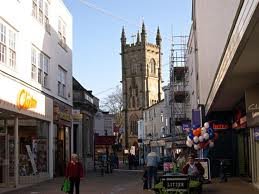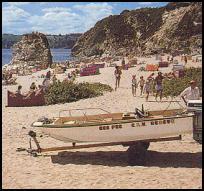


Capital of the Cornish Alps
Web: www.staustell.co.uk
Web: www.staustelltown.co.uk
Web: www.staustellbay.co.uk
Web: www.visitcornwall.com/destinations/st-austell
The main town on the south coast of Cornwall lying on the A390 main road, fifteen miles east of Truro and ten miles south of Bodmin. The keynote of this busy town is variety and versatility. It is the largest town in east Cornwall and has developed into a shopping and market centre catering for a large area. It is the focal point of the china clay district, most of the mining companies having their offices in the town and some of the china clay is exported from the suburb of Charlestown. It is also a holiday centre and resort in its own right. Many tourists make it their base for exploring eastern and central Cornwall and, although the centre of the town is over a mile from the sea, it can nevertheless claims to be a seaside resort because of the suburbs of Carlyon Bay, Charlestown and Porthpean built along the coast. The town itself is the meeting point between old and new Cornwall, of ancient narrow streets and smart pedestrian precincts with fine shops. The population of the town was 20,441 at the 2011 census.
St. Austell was transformed by the discovery in 1746, by the chemist William Cookworthy, of huge reserves of china clay to the north and west of the village. By the 1850's, some 7,000 men, women and children were employed in the St. Austell clay district in the extraction, processing, transportation and export of the clay, and heavy wagons constantly rumbled through the streets of St. Austell on their way to the ports of Charlestown, Pentewan and Par. The development of the china clay industry can be seen at Wheal Martyn Museum.
The heart of St. Austell has to be its fine perpendicular-style Holy Trinity parish church, built of the mellow elvan stone quarried at Pentewan. The Nave and the 94 foot high tower were built in the 15th century. One of the monuments within the church is to the Sawle Family of Penrice House, who were great benefactors to St. Austell.
One of St. Austell's most impressive buildings is The Queen's Head Hotel, which is one of the oldest buildings in the town, dating from the 17th century when it was an ale house.
Another long running industry in the town is St. Austell Brewery. Founded in 1851 by Walter Hicks it has grown to become easily the biggest brewery in Cornwall with a string of pubs. The brewery is open to the public for tours.
St. Austell's Market House, designed by Cope & Eales of London, and built by Olver & Son of Falmouth, opened in 1844 at a cost of £7000. Public meetings and exhibitions were held in the market house and both William Gladstone and Winston Churchill have addressed St. Austell residents from the landing.
In 1926 a new by-pass was opened on the southern side of the town including the White River Bridge over the St. Austell River a short distance down from the old river crossing.
Work started in 1963 on a new pedestrian precinct which lasted until 2008 when it was re-developed again and then called White River Place. The White River Cinema also opened at this time, and later the Eden Project Cafe also opened in the precinct.
Perhaps the towns biggest draw these days is it's proximity to the mighty Eden Project , only two miles away. Eden is now, without doubt, the most popular single tourist attraction in Cornwall. Interestingly enough the biomes were built in an old china clay pit.
The great sweep of St. Austell Bay and its hinterland play host to a vivid range of scenery, spectacle and activity, compounded by a location which makes it a natural touring centre, within an hours drive of most major attractions in the county.
A drive north will take you to Roche, noted for its towering rock with the chapel of St. Michael built into the summit, a natural sound stage for the Cornish Gorsedd celebrating pre-Christian oral tradition.

Nearby, is the bijou port of Charlestown, little changed since its completion in 1795 by the brilliant local entrepreneur, Charles Rashleigh. Its Shipwreck and Heritage Centre, built over the old china clay dry, charts a fascinating 100 year history of fishing, wrecking, mining and migration to North America. On display in the harbour you will find traditional square rigged sailing ships, and at various times, famous visiting tall ships, aboard which you can discover a world from many years ago.
Charlestown has its own beach and St. Austell Bay also offers outstanding cliff and coastal scenery with beaches at Carlyon Bay, Porthpean, Pentewan and Par where you will find a lake whose many species of bird make it a naturalist's paradise. Carlyon Bay was also home of Cornish Leisure World, but the site is now being re-developed. Across the water, tucked into the hillside between Par and Fowey is the small, picturesque harbour of Polkerris with its sandy beach from where you can hire a boat or pedaloe and explore the Bay.
The patron saint of St. Austell, (Saint Austol or Austolus) was a sixth century Cornish holy man who lived for much of his life in Brittany. The parish and town of St. Austell is named in his honour.
Approximately 1.5 miles to the east of St. Austell, the menhir (standing stone) known as the Gwallon Longstone stands in the grounds of Penrice Community College. Recorded in 1740 as being 13 feet in height, it is one of the best-preserved longstones in the county.
Menacuddle Holy Well which was once held in high regard for its curative powers is only about 0.5 mile north of the town just off the B3274.
St. Austell has its own hospital, St. Austell Community Hospital, formerly called Penrice Hospital.
Only three miles south of the town are The Lost Gardens of Heligan which were re-discovered in 1990 after being abandoned during the first World War, and are now being restored.
St. Austell still has a railway station on the main line through Cornwall which opened in 1859, and still uses one of Brunel's viaducts. Adjacent to the railway station is the bus station which opened in 1908.
The town's Tourist Information Centre is at Bypass Service Station, Southbourne Road, PL25 4RS.
The local leisure centre is in Carlyon Road, PL25 4DB.
The Clay Trails are a group of mostly traffic-free Trails, three to five miles long all around the St. Austell area.
The nearby South West Coast Path offers many miles of scenic walks along the Cornish coast in both directions.
Dr Alfred Leslie Rowse CH FBA (1903-1997), Was a historian and poet born at Tregonissey near St. Austell.
John Nettles (1943-), the actor in the series Bergerac and Midsomer Murders was born in St. Austell.
Robert Duncan (1952-), the actor was also born here .
Daniel John Rogerson (1975-), A St. Austell born British Liberal Democrat politician. He was the Member of Parliament for North Cornwall from 2005 to 2015.
Dr James C A Whetter (1935-2018), Historian and Politician was born in St. Austell.
David William Phillips (1924-2016), Airline Pilot and Aerobatic Champion was born in St. Austell.
John Arthur Philips FRS FCS (1822-1887), Geologist born at Polgooth near St. Austell.
John William Colenso (1814–1883), Born in St. Austell was a British mathematician, theologian, Biblical scholar and social activist, who was the first Church of England Bishop of Natal.
Paul Rapsey Hodge (1808-1871), Inventor of the fire engine was born in St. Austell.
D-Day veteran Horace "Harry" Billinge (1926-2022), from St. Austell has died aged 96 following a short illness, his family has confirmed. Mr Billinge,was 18 when he was a sapper attached to the 44 Royal Engineer Commandos ahead of the Normandy landings.
Nigel Martyn (1966-), Footballer born in St. Austell.
Jonathan Fox MBE (1991-), Paralympic swimmer who lives in St. Austell.
St. Austell Feast Week - early July.
Torchlight Carnival - mid November.
Celtic Beer Festival - end November.
Charlestown Fowey Lostwithiel Luxulyan Luxulyan Valley Mevagissey Par Pentewan Polkerris Roche
Grampound St. Stephen St. Austell Town Museum St. Austell Brewery The Eden Project
The Heritage Trail Penrice House The Tortoise Garden Knightor Winery Porthpean
Pinetum Gardens Wheal Martyn Museum The Clay Trails The Lost Gardens of Heligan
St. Blazey Gribbin Head Probus St. Ewe Tregony Par Market Kidzworld Cornwall's China Clay Industry